|
|
|
Movikon K 16 -Zeiss Ikon 1938
The camera was produced by Zeiss Ikon Ltd. The model came to the market in 1938, just one year before the war. The cost of new camera was under half price of the early model Movikon 16, built up in 1935.
In the English market, the camera appeared at the beginning of the 1939. It was priced; with f/2.7 Zeiss Tessar lens - £31 0 0; with f/1.4 Zeiss Sonnar - £41 10 0.
Picture from Zeiss Ikon AG. Dresden Catalogue - July 1938 (in our collection)
Construction and Finish
The metal parts of the camera body are die-cast aluminium polished and some are satin chrome, and tiny pieces of real chrome.
The camera does not have its name engraved on the body. The name is only embodied on the camera handle and on the side door body (top right picture). The external and internal fittings are plated and bright polished, with the exception of the winding handle and the face plate on which the lens is mounted. These have a light gray semi-matt metal finish.
The camera was produced in two colors of the leather: black and gray.
It is a rare camera, particularly in black finish.
Film size and loading, footage, speed
- Cassette system - 16 mm film Kodak magazine - 50 foot, in our camera; The magazine was introduced for the Magazine Cine Kodak. It has to be slide back the shutter on the gate portion of the magazine before loading it into the camera.
- Automatic film footage counter, below light exposure on the back side of the camera, which only comes into operation when a magazine is loaded into the camera. It presses on a small plunger in the interior adjacent to the footage meter.
The speed control, which is a rotatable button with knurled head, placed under the lens, gives infinite variety of speed: 8; 16; 24; 64 fps;
Lens
The lens mount is of the bayonet type, with a small release button enabling quick removal and replacement of the objective.
Lens; Carl Zeiss Jena NR. 2117333 Tessar 1:2,7 f=2cm; focusing lens; the lens was made in 1937; A Zeiss Sonnar f/1.4 can be obtain as an alternative.
- Fields of view for the 2 cm and 2.5 cm lenses are built into the camera viewer;
Motor and exterior features
The right side of the camera bears the motor anti clockwise winding crank, which tucks down flat when not used. It takes 48 turns to wind the camera fully.
Single exposure and continuous run is adjustable with the button below of the winding handle; Letter “L” - continuous run, letter “E” for single picture;
Above this is a small button for positioning the mask flipped into the viewfinder for telephoto lenses 5 and 7.5 cm. Both those controls are rotated with the finger tip on their knurled outer faces.
At the top left is the eyepiece of the optical viewfinder, which can be slipped upwards to accommodate for parallax(by adjusting vertically the viewfinder eyepiece);
The camera has a cable release socket.
A few additional words
In the review published in Amateur Cine World - March 1939 was told “This may be termed an ‘aristocratic’ version of the magazine type of instrument. It is really handsome in appearance, well designed, comfortable and efficient to handle.[...] On the focussing scale of the lens is a red dot, and on the aperture scale another, and when these are opposed to two black dots also on the lens the instrument can be used as a ‘ fixed focus’ camera - an advantage to the tyro.”
As the camera was produced for only one year before the outbreak of WWII, not so many were manufactured.
Production number W.75433 - exposed in front of the camera and inside.
|
|
Movikon K 16 in our collection; © Anna Vacani
Movikon K 16 with the original Zeiss box ; © Anna Vacani
Movikon K 16 with the original Kodak magazine; © Anna Vacani
Movikon K 16 in our collection; © Anna Vacani |
|
|
|
|
|
|
|
Movikon 16 - Zeiss Ikon 1935
The camera was produced by Carl Zeiss Ikon. The model came to the market at the beginning of the 1935.
The Magazine “Amateur Cine World” 1935 February edition, published “The reports on new apparatus”, where the Movikon 16 camera was described as new to the market. The camera was named as for “the processional camera-man”.
The body is built up from die casting alloy covered with the black leather.
The measurements: dimensions: 20 x 17 x 7 cm (7 7/8 in x 6 3/4 in. x 2 3/4 in.), weight; 2 kg.
The markings on our camera are in German language. Our camera is second version. The camera has a few new features comparing to the first 1935 version: cable release socket and the second shoe mounted on the camera door, which was used for the tubular special finder for the 5.5 cm lens - look in the Pict.1 on the right mirror.
Features:
- Lens: Carl Zeiss Jena Nr.2584508; Sonnar 1:1,4; f=2,5 cm. The lens was coated and is marked with the letter “T”; The lens number indicated 1939 year of production; Lens in bayonet mount; the lenses are automatically coupled two the rangefinder and to the viewfinder for parallax correction;
- 50 ft or 100 ft of film spool; black and white or colour;
- Semi-automatic release of the sprocket rollers; (Pict. 3) and feed sprocket;
- Peephole for direct focusing on the film (Pict 3 - it is visible inside as well - small square window and Pict. 1- right mirror- the round button);
- Tell-Tale for automatic delayed action release ( a piece of paper or card clamped under the hook falls away directly the film starts) - Pict.5 - left bottom corner;
- Shoe mounting for universal finder for various focal length of lenses with automatic parallax correction; the finder is missing in our collection;
- Rotating wedge distance meter coupled to the lens focusing:
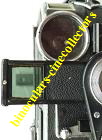 |
- Focussing lever for lens, distance meter, and parallax correction; (Pict. 5 - below the lens);
- Angle viewfinder for taking pictures at right angles to the subject; (Pict. 4 - top left corner); and the viewfinder in the back of the camera;
- Footage indicator for use in connection with automatic delayed action release; Picture 4 - top round window and below button;
_ Film footage meter, showing length of film exposed; Picture 4 bottom round window;
- Setting disc for single picture action; (Pict. 1 top right button):
- Setting disc for selftimer (Pict. 2 below the wounding handle);
- Adjustable speed: 12, 16, 24, 64 fps;
- Rewind spindle for mixes - below selftimer button;
- Adjustable shutter exposure mechanism: pictures per second: 12; 16 = shutter exposure 1/25-1/200; 1/30-1/300 sec. Picture per sec: 24; 64 = shutter 1/50-1/450; 1/125-1/1000 sec;
- The angle of the shutter opening can be varied by means of a small knurled wheel built into the body of the camera,
and it gives a variation through four settings: 180 degrees (normal), 90, 45 and 20 degrees. Varying the shutter angle alters the exposure time, and a chart on the back of the camera gives the necessary adjustments; the chart gives also a normal exposure chart; (Pict. 1- the left mirror):
- English adapter is in the tripod socket;
Accessories:
- Telephoto lens: Carl Zeiss Jena Nr.2786209; Sonnar 1:4; f=7,5 cm. The lens was coated and is marked with the letter “T”; The lens number indicated 1941 year of production;
- Rewind handle;
- Two filters in original Zeiss Ikon containers.
Production number W 35315
|
|
Picture 1
Picture 2
Picture 3
Picture 4
Picture 5
|
|
|
|
|
|
|
|
Agfa Model - Movex 16-12 B - 1928
The camera was produced by Agfa Camerawerk, M√ľnchen in Germany.
The camera body is built up from aluminium and steel, covered with the black leather. The dimension of the camera is: 69 x 125 x 165 mm. The camera is rather very heavy for that measurements, it is 1,900 kg. The body is in a new condition. The camera is in the original Agfa hide leather case.
Features:
- Lens: Agfa Kine Anastigmat; F: 3,5, f=2 cm; the lens has a close up focusing adjustment: 1 - 3 m (3 -10 ft); 2 - ‚ąě (7 feet - ‚ąě);
- The camera runs at one speed only - 16 frame per second (fps);
- Two viewfinders: optical direct vision viewfinder and waist level viewfinder;
- The spring-wound, clockwork motor;
- The footage counter, on the top of the camera:
- Agfa cassette in the camera of double perforation run 16 mm film - 12 meters length; the loading mechanism looks like in the picture, before loading - the film gate and film sprocket guides opened by depressing two pins:
and after loading the film sprocket guides has to be pushed together:
- Normal running operation and lock on running; below starting knob is the adjustment mechanism for filming: 0 ; I ; II;
- Light exposure above lens
Accessories: the Agfa container for the film.
Production number: 8779; in the chamber of the camera is second number, presumably a lens number: 365233 |
|
|
|
|
|
|
|
|
|
Agfa Model - Movex 16-12 B - 1928
The camera was produced by Agfa Camerawerk, M√ľnchen .
The features are exactly the same as the camera above.
The camera is in a new condition.
Production number: 6122; in the chamber of the camera is second number, presumably a lens number: 347257
|
|
|
|
|
|
|
|
|
|
Agfa Model - Movex 30 B - 1935
The camera was produced by Agfa Camerawerk, M√ľnchen in Germany.
The camera body is in rectangular shape with rounded corners. It is built from die-cast aluminium alloy, covered with the black embossed leather and with chrome fittings.
Dimensions: 224 x 111 x 50 mm; weight: 200 gram.
Features;
- Lens: Agfa Kine Anastigmat; 1.5 f=20mm; the lens has a special Agfa bayonet mount;
- Supplementary mask for the telephoto lens, fitted near the side of the front viewfinder window as a tiny slider;
- The camera takes 30 meters film spools double perforated;
- The film counter in 100 feet;
- Speed; 8 and 16 fps;
- Two film sprocket;
- The loading mechanism looks like in the picture, before loading the film gate and film sprockets guides - looks like a small scissors are opened by pushing two pins forward:
and after loading the film sprocket guides has to be pushed together:
- Normal running filming;
- The camera is fitted, in unusual way, with two tripod bush: English and continental;
Note: we have seen that the camera was used in German army, during the WWII.
Production number: 45824 |
|
|
|
|
|
|
|
|
|
G.B. Bell & Howell - Model Autoload 603 1952
The camera was made in England from American parts of Bell & Howell.
Two words “G.B. “ can be stand for Gaumont-British — British leading film company since 1932. In 1933 the company opened a new division to manufacture 16 mm sound projectors and in December 1933, under the name of Gaumont British Equipments, begun to produce a series of 16 mm sound projectors.
After the war the Gaumont-British name remained, even though the Corporation had been absorbed be the Rank Organisation, negotiated a license to manufacture British version of Bell &Howell range as G.B. Bell & Howell.
The history of the G.B. Bell & Howell based on Gerald McKee book - “The Home Cinema. Classic Home Movie Projectors 1922 - 1940”.
In the magazine: “Amateur Cine World” - edition June 1952, was an advertisement of that camera, as new on the English market. The price was ¬£68, with case ¬£105.
The body is made from aluminium alloy, covered with light brown synthetic leather.
Features:
- Lens: Super Comat 1 inch f/1.9 focusing lens; made by Taylor, Taylor & Hobson Ltd. England; the lens is bloomed; an interchangeable lens mount permits a telephoto lens to be fitted; Viewfinder lens: for 1 inch. on Filmo 16 G.B. Bell & Howell.
When the camera lens is changed the viewfinder lens has to be changed as well to match the camera lens.
- Standard Kodak 50 ft capacity magazine; the magazine is in our camera;
- Single frame release (start button up); Continuous running (start button down); Release button can be locked for continuous running;
- Five speeds: 16; 24; 32; 48; 64 fps;
 |
- Exposure calculator and film counter (round small window below):
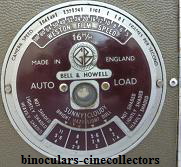 |
Production number: 610 |
|
|
|
|
|
|
|
|
|
Siemens Model B 1932
The camera was made in Germany by Siemens & Halske AG Wernerwerk, Berlin Siemensstadt for the German market. On the camera body is a stamp of the shop where the cameras were sold - ‘Photohause - Baleui & Rabe, H√ľndelstr. 1’. It is difficult to read all words, on that stamp:
The camera was produced in 1932, as on the Carl Olaf’s web site:
http://www.olafs-16mm-kino.de/Anleitungen/Siemens%20Preisliste%201932.pdf
is inserted a catalogue of the prices of the cameras 16 mm, in that year.
The camera body is made from pressed steel covered with black leather.
Dimensions: 125 x 70 x 135 mm; weight: 1,5 kg.
Features:
- Lens: Busch-Glaukar Anastigmat, No 363483 ; F: 2.8; F=2 cm; the lens has a close up focusing adjustment in meters: close up: 1,5 - 3 m; distance 10 - ‚ąě; portrait: (0,8-1,2) lens (1 - 1,6);
- Speeds: 8; 16; 64 fps;
- Single picture; normal running and continuous filming;
- Viewfinders: optical direct vision viewfinder and waist level viewfinder;
- The table exposure around the lens, in German language;
- 50 ft magazine of 16 mm film; our camera is complete with magazine
- The footage counter (in the picture - top left corner);
- In the film chamber is a further instruction: ‘wind up spring motor before inserting cassette’:
The camera is in very good condition.
Production number: 8126 |
|
Camera logo |
|
|
|
|
|
|
|
Siemens Model B 1932
The camera was made in Germany by for the English market. All feature are the same except:
- The table exposure is in English language:
The description in the camera house is in English as well:
On the side is a little different logo of the Simens and the engraved plate - Made in Germany:
Production number: 6369 |
|
|
|
|
|
|
|
|
|
Ditmar - Model with built in Optical Exposure Meter 1936/1937
The camera was made in Austria by Ditmar R. Gebr√ľder Br√ľnner AG, Vienna, Austria. The first model had been appeared on the market, probably at Christmas 1936. In “Amateur Cine World” magazine, September 1936 edition, was an announcement: “The Ditmar camera 16 mm model available shortly”.
Our camera was produced after 1938. In the film chamber is engraved information: “Made in Austria” when on the body side is the label: “Ditmar Made in Germany - Fabrique en Allemagne”
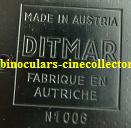 
The camera is similar to model 9,5 mm (look: Cine Collection - Cameras 9,5 mm p. 3)
Features:
- Lens: Berthiot Paris Cinor No 308467 1: 2,8 F=20;
- Built Optical exposure meter - In the viewfinder is visible, above the picture, a stepped wedge giving a range of densities; Pict 2 - the top corner
- Sliding eyepiece to viewfinder eliminates horizontal parallax on close-ups. Vertical parallax nonexistent;
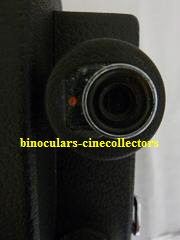 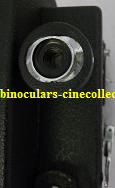
- Separate control buttons of instant change at any time - from 16 to 32 fps (two buttons below the lens - Pict 2);
- Slide control for lens aperture permit adjustment even during the filming. Indicator shows in viewfinder(picture 3 - top right corner);
- The camera takes 50 ft spool, double perforated film;
- Sprocket feed - Pict 4;
- Hand crank for the single picture (at the bottom right corner-under the cover plate - Pict 3), missing in our collection;
Production number: 1006
|
|
Pict 1
Pict 2
Pict 3
Pict 4 |
|
|
|
|
|
|
|
Page back Page (1) (2) (3) (4)
|
|
|
|